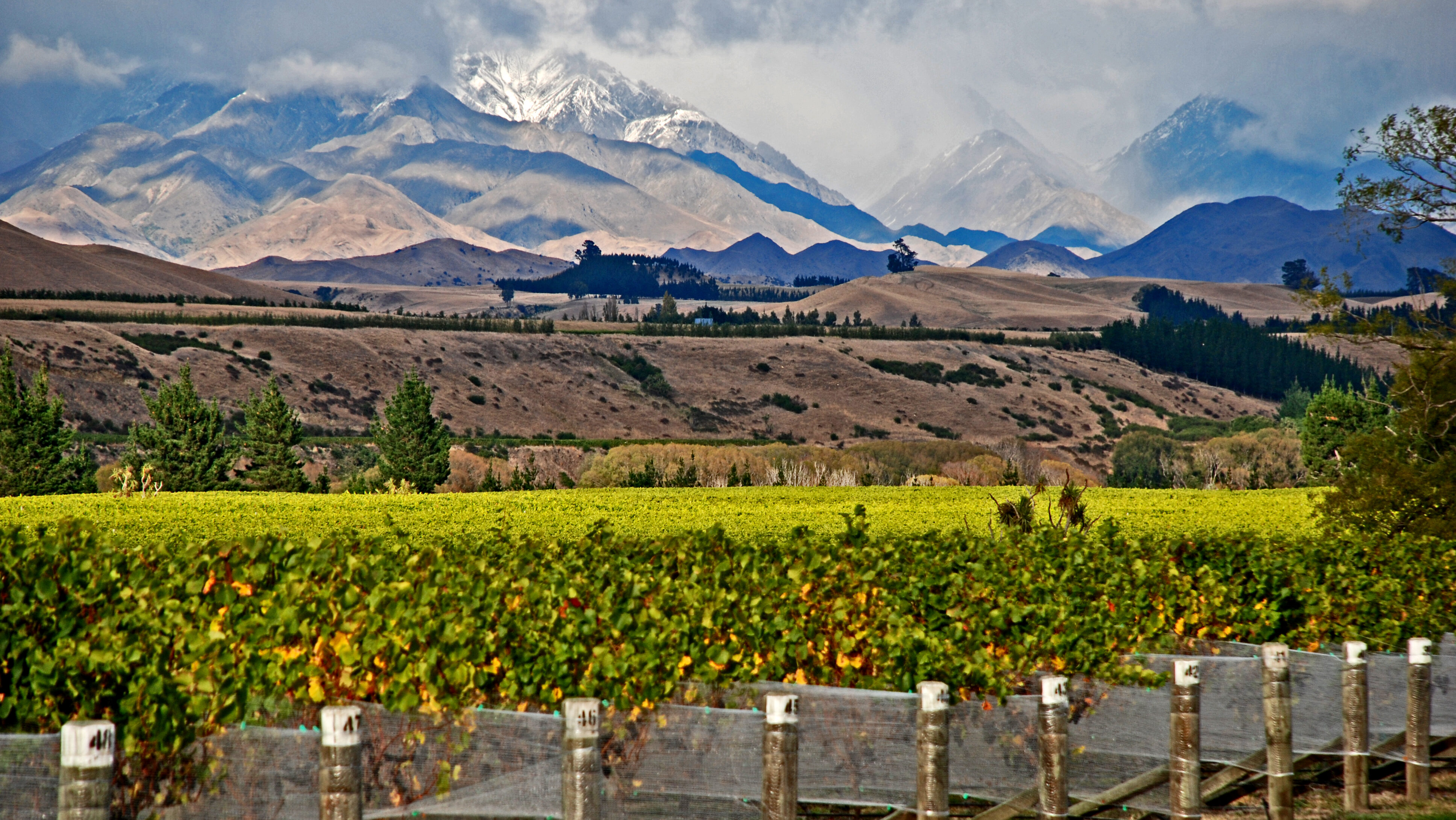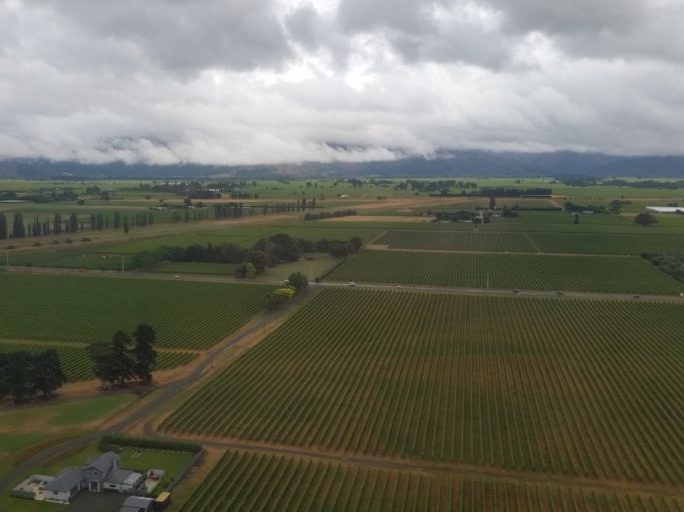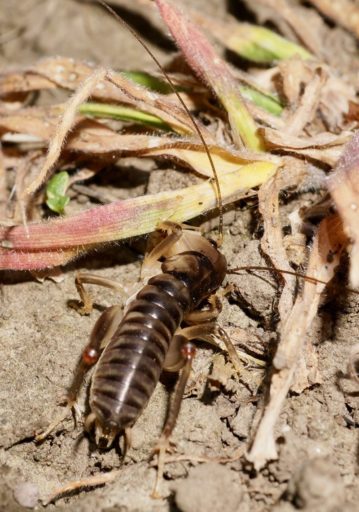It’s not often you hear of native species benefitting from human modifications of its habitat – but one little-known wētā species has gone against trend and embraced the changes in its world. It’s been nicknamed the ‘wine wētā’ due to its fondness for hanging out in Marlborough vineyards and scientists have recently been trying to find out more about it.

The wine wētā is a type of ground wētā and has been found at high density in Awatere vineyards where plastic sleeves are placed around vines to try and prevent the wētā from feeding on buds and leaves. But when researchers checked out its lifestyle they found the wine wētā’s diet isn’t strictly vegetarian. It may also be a predator of other pest species. Here’s what they learned…
“Wētā are a well-recognised component of New Zealand nocturnal ecology, but much of the diversity remains undescribed and only partly characterised. Species of Hemiandrus conceal themselves during the day in soil burrows and most are infrequently encountered, however, one taxon is notorious in some South Island vineyards. We demonstrate that this wētā at unusually high density in some vineyards in the Awatere valley is also found in North Island forests (Hemiandrus bilobatus).”
What’s a North Island forest-dweller doing in Marlborough vineyards? The climate and history of the region gives some clues.
“Situated in the northeast corner of South Island, the Marlborough region experiences hot sunny days and cool nights, conditions which prolong grape ripening times generating the intense wine characteristics (especially in the Sauvignon blanc variety) for which the region is recognised worldwide. Marlborough was once vegetated by native forest but this was replaced by bracken scrub following Polynesian fires. Exotic grasslands later developed under European pastoral management with sheep grazing dominating the landscape before the planting of vineyards began in the 1970s.”
Perhaps vineyards are a replacement for the wine wētā’s lost forests.
The wine wētā has most impact on the grape vines during the spring when it feeds on the new opening buds, sometimes reducing grape yield.

“Wētā activity on grape vines is currently managed by attaching plastic sleeves around vine trunks because it is thought this slippery surface makes it difficult for wēta to ascend the stems. Despite several studies directed at identifying the scale of impact on grape harvest and at finding solutions, the identity and behaviour of this wētā has not been addressed. In part this reflects taxonomic uncertainty in the group as a whole, but it is clear that the wētā concerned belongs to the ground wētā genus Hemiandrus, which typically reside in closed burrows in soil during the day and emerge only at night.”
Although wētā are wellknown among our insects, many of the diverse wētā species are undescribed and their biology poorly known.
“The true wētā of New Zealand belong to the Anostostomatidae, comprising three main lineages; giant and tree wētā, tusked wētā and ground wētā. The ground wētā lineage is the most speciose, with fourteen described species. These 14 Hemiandrus species are supplemented by dozens of ‘tag-name’ entities, including the taxon associated with viticulture, representing diversity of uncertain taxonomic rank.”
“Here we provide new data on the natural history of the wine wētā using observations at night in vineyards and examination of gut contents. We identify the wine wētā using diagnostic morphological traits and evidence from DNA sequences and describe four new species of ground wētā belonging to the same clade of short-ovipositor New Zealand Hemiandrus as the wine wētā.”
Field observations of wine wētā were made in the Awatere valley during early October 2018 and 2019 at the time of grape vine bud burst when the wētā are thought to do most damage to the crop.
“The Awatere valley has many vineyards although anecdotally the wine wētā are a concern for growers only in the eastern, seaward part of the valley. Our field site was Cable Bay vineyard which has a number of grape varieties in close proximity and management includes irrigation and use of plastic sleeves on vine main stem (trunk).”
Nail varnish was used to estimate population density.
“We searched the ground at night along vine rows and marked each wētā seen with a spot of nail lacquer on the pronotum (October 2018). On the subsequent night we search the same ground, recorded all wētā seen and whether they had been marked. Separately we observed ground wētā during the night (after 20:30h) on the trunk, stems, branches and leaves of grape vines. We recorded whether each vine examined had a plastic sleeve on its trunk or not. The plastic sleeves attached to grape vine trunks are an attempt to reduce wētā access and some had dropped off vines (apparently at random) and not been replaced. We analysed presence/absence of wētā and sleeves.”
The researchers also observed what wētā were eating and even provided a selection of additional foods to check out their tastes.
“To gauge the range of food types consumed by wine wētā in the spring we used direct observations at night when the insects were active, including on artificial feeding arenas provided with protein (either thawed beetle larva or cat biscuit), carbohydrate (rolled oats), and fruit (apricot pieces). We also examined crop contents of wine wētā collected by hand at night, in pitfall traps, and opportunistically during digging holes for vineyard trellis posts. Wētā preserved in ethanol were dissected so that contents of the gut could be examined. We used stereomicroscopy to identify any large particles including fragments of invertebrate exoskeleton, and then bleached and stained (with basic Fuchsin) smaller particles mostly comprising plant matter.”
Results showed there were a lot of wētā in the Awatere vineyard, but most were on the ground, not on the vines – and they weren’t just sticking to plant material in their diet.
“From night time mark-recapture observations within an area of 480 square metres of an Awatere vineyard we calculated there were approximately 1700 ground wētā. This yields an estimated ground wētā density of 3.4 individuals per square metre. Although ground wētā density is high near vines, most of the active wētā we observed at night were on the ground. For example on one night in the vineyard, of 163 wētā observed along vine rows only 6 (3.7%) were on vine plants. However, direct observation confirmed that ground wētā do climb vines and we saw some wētā eating buds, while others were feeding on sap or were moving and not feeding.”

The wētā seemed to appreciate the supplementary feeding too.
“We also observed ground wētā at night eating food provided. Only four of 19 experimental replicates had all three food items available when observed at 20:30h, however we directly observed ground wētā eating each of the three food items provided (cat biscuits, oats, apricot). In addition, slugs, earwigs and harvestmen were seen on the food. We examined the gut contents of seven wētā collected directly from vines (November 2019), and 11 from pitfall traps placed at the ends of vine rows (October–November 2018). Of these 18 gut samples, 12 contained fragments of invertebrate exoskeleton as well as plant material. Of 10 samples with sufficient material that were stained and examined with a compound microscope, five contained trichomes and/or leaf cuticles that were characteristic of vine leaves. These and others contained cuticle fragments representing several other plant taxa but we did not attempt to identify these.”
The plastic sleeves seemed to have little protective effect for the vines.
“At night we observed ground wētā on the trunks, stems and branches of grape vines. We recorded whether the vine on which wētā were observed had a plastic sleeve on its trunk or not. On 5th October 2018 the rows we examined had a ratio of about 12 plants with sleeves to every plant without a sleeve (358:29). We observed 24 ground wētā on these 387 vines, 21 were on plants with sleeves, 3 on plants without sleeves, which did not differ significantly from random occurrence.”
The ground wētā found in Awatere Valley vineyares were identified as belonging to the species Hemiandrus bilobatus, first described in 1938 and thought to occur only in the southern tip of North Island. This species is unusual in that females don’t have the long ovipositors seen in many wētā species. Also unusual, is the female’s behaviour in laying her eggs in her own burrow and remaining with them, rather than injecting eggs singularly into soil or plants and then having no further care of them.
“From direct observations at night in vineyards we can confirm that these ground wētā are omnivores. Our analysis of gut contents of individuals active in the vineyard found most had eaten a mixture of plants and invertebrates. Half the sample had vine and two-thirds of our sample had invertebrate exoskeleton in their gut. This species is known to eat a large range of plant species but by using primers to amplify plant DNA from their frass all the invertebrate components of their diet has, until now, largely been ignored. Because protein is known to improve growth rate of this species and observations of many Hemiandrus species suggest a diet described as primarily carnivore, scavenger or omnivore, the potential role of wine wētā as predators of other pest species should not be ignored.”
So the wine wētā may have a beneficial role in vineyards as well as its less-beneficial bud-eating habits.
“Although wine wētā density is high near vines, most of our night observations were of wētā on the ground. At night in early October, few vines (∼6%) have wētā feeding on the buds. Although over the course of the season it can be expected that the cumulative number of wine wētā/vine interactions could be high, damage to leaves that are protected by masses of woolly hairs (trichomes) is likely of limited consequence. We found little evidence that the plastic sleeves wrapped around the trunk of grape plants reducing the rate at which wine wētā climb vine trunks.”
“We can confirm from direct observation that Hemiandrus bilobatus ground wētā do climb grape vines in the Awatere valley, something that has not previously been documented. We can also confirm that they do forage on vine buds, but ground wētā spend time in vegetation for many reasons including hunting, premating signalling (drumming) and mating.”
The Awatere valley’s vineyards are, it seems, the closest modern-day equivalent of the forests which covered the region in pre-human times.
“Finding ground wētā on vines is not surprising given that vines represent the only large plants in the area. Rarely in New Zealand are native animal populations influenced positively by anthropogenic habitat modification but in the Awatere Valley the irrigation of vines seems to provide Hemiandrus bilobatus with suitable conditions to thrive. Further work on the biology of this species throughout the year would be useful to elucidate its role as predator within this system, and indeed to learn about the evolution, ecology and resilience of endemic biodiversity in a rapidly changing world.”
The full article is published in the New Zealand Journal of Zoology and is freely available online.

